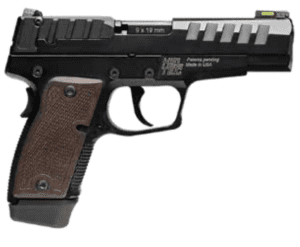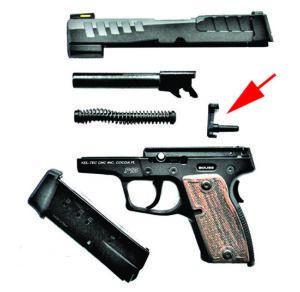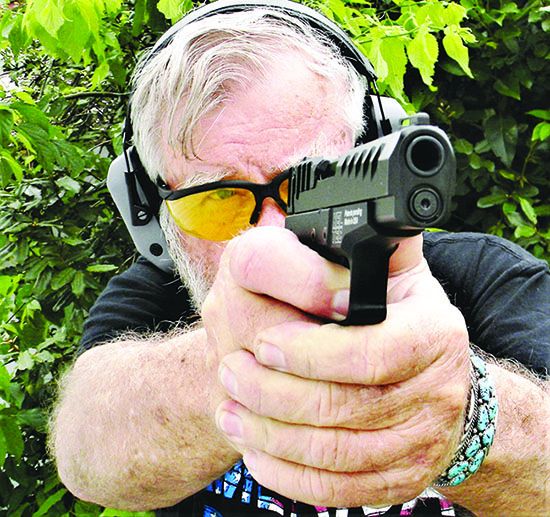The newest and quite popular trend in concealed-carry handguns is to stuff as many 9mm Luger cartridges as possible into as slim a profile as possible. Four guns that incorporate these criteria are the Israeli Weapon Industries (IWI) Masada Slim, the KelTec P15 in both polymer and metal frames, and Smith & Wesson’s new Equalizer.
The Israeli Weapon Industries Masada Slim M9SLIM13, $415, is a subcompact version of the full-size striker-fired polymer Masada. The Slim measures only 1.1 inches in width and weighs only a skosh above 25 ounces loaded. It’s a smaller version of the full-size Masada introduced a few years ago.
KelTec boldly proclaims the new P15 pistol is the slimmest high-capacity handgun out there, and we are hard-pressed to find many that are skinnier. The KelTec P15 Metal P15MBLK, $634, and KelTec P15 Polymer P15BLK, $445, are fresh designs owing nothing to any previous KelTec pistol. We thought availability of the metal-frame P15 would be months behind the polymer P15, but we were able to find an example virtually as soon as the polymer-frame P15 was available. For $189 more on the Metal P15, you get an aluminum frame, an ounce and a half more weight, and lose the ability to mount a combat light.
The Smith & Wesson Equalizer TS 13591, $476, is a high-capacity version of the S&W EZ Rack pistol and the manual-safety version, which we prefer. This is an internal-hammer single-action pistol, and we don’t feel comfortable relying only upon a grip safety. Smith & Wesson entered this potentially lucrative market by upping the capacity of a proven handgun, the Military & Police Shield EZ Rack. We have tested several EZ variations in 380 ACP, 30 Super Carry, and 9mm Luger and have had good results. We were eager to see how the Equalizer would do.
We tested these pistols for combat ability, accuracy, and reliability. There is a balance between affordability and performance, but reliability can never be compromised. In the end, this was a close race. We really liked all four pistols tested, but none had everything we wanted.
KelTec P15 Metal P15MBLK 9mm Luger
$634
GUN TESTS GRADE: A
We like the metal-frame KelTec. Some raters felt it was a waste of money because the polymer-frame pistol is a good shooter. Others felt that the metal frame makes a significant difference in handling and comfort. You are not likely to mount a combat light in concealed carry, but just the same, there is no option to do that with this handgun.

| Action Type | Semi-auto striker fired |
| Overall Length | 6.6 in. |
| Overall Height | 4.8 in. |
| Maximum Width | 0.9 in. |
| Weight Unloaded | 15.2 oz. |
| Weight Loaded | 20.2 oz. |
| Slide | Steel w/polymer cover |
| Slide Retraction Effort | 9.6 lbs. |
| Receiver material | Black anodized aluminum |
| Front Strap Height | 1.5 in. |
| Rear Strap Height | 2.8 in. |
| Barrel | 4.0 in. long |
| Grip Thickness Max. | 1.1 in |
| Grip Circumference | 5.1 in. |
| Magazines | One each 12, 15 round |
| Rear Sight | Two dot fiber optic |
| Front Sight | Single Dot fiber optic |
| Sight Radius | 5.0 in. |
| Trigger Pull Weight | 5.0 lbs. |
| Trigger Span | 2.375 in. |
| Safety | Grip |
| Warranty | Limited Lifetime |
| Telephone | (321) 631-0068 |
| Website | KelTecWeapons.com |
| Made In | U.S. |
Notably, the P15 Metal’s slide is the same as on the polymer-frame gun, save that the striker assembly cover is metal in the P15 Metal. Many polymer-frame handguns are purchased these days, and a few makers are offering a metal frame at an increased cost. For example, the KelTec Metal weighs 1.6 ounces more than the polymer-frame version. This isn’t really enough to make a different in recoil impulse.

In general, polymer-frame handguns are considered slide heavy, but a qualified shooter will fire the type well. However, there are other important factors. The P15 Metal pistol is about 0.02 wider than the polymer-frame version. Total grip circumference is 0.3 greater. The greater difference is in the front strap design. The front strap on the P15 Metal is nicely checkered and much more comfortable. The grip design makes a great difference in handling.
We were surprised at just how great a difference and how much more comfortable the metal-frame pistol was to fire. With the Polymer gun, comments regarding its recoil and the sting of the frontstrap were uncomplimentary. Just the same, by bearing down with each pistol, the target results were comparable. In extended range drills, the aluminum-frame P15 could be handled longer and more accurately than the P15 Polymer, as momentum takes its toll. Accuracy results were similar to the Polymer P15, with groups as small as 1.9 inches.
Our Team Said: We liked the aluminum-frame P15 a great deal. As one rater noted, this is a slick pistol. For a greater outlay of cash, you get a pistol that is very slim and light and easier to shoot well than the polymer-frame P15. A couple of raters didn’t feel the P15 polymer-frame gun was that abrasive. Older raters were the chief complainers. In the end, this is a nice pistol that is reliable and accurate.
| 9mm LUGER Range Data | ||||
| Remington HTP | Smith & Wesson | KelTec P15 | KelTec P15 | IWI |
| 115-grain JHP 28288 | Equalizer | Polymer | Metal | Masada Slim |
| Average Velocity | 1169 fps | 1155 fps | 1146 fps | 1160 fps |
| Muzzle Energy | 349 ft.-lbs. | 341 ft.-lbs. | 335 ft lbs | 344 ft.-lbs. |
| Smallest Group | 1.5 in | 2.0 in. | 2.0 in. | 1.9 in. |
| Average Group | 2.0 in. | 2.6 in. | 2.7 in. | 2.3 in. |
| Federal HST | Smith & Wesson | KelTec P15 | KelTec P15 | IWI |
| 124-grain JHP P9HST1 | Equalizer | Polymer | Metal | Masada Slim |
| Average Velocity | 1159 fps | 1150 fps | 1141 fps | 1164 fps |
| Muzzle Energy | 370 ft.-lbs. | 364 ft.-lbs. | 358 ft.-lbs. | 373 ft.-lbs. |
| Smallest Group | 1.6 in. | 1.9 in. | 2.1 in. | 1.9 in. |
| Average Group | 2.0 in. | 2.3 in. | 2.4 in. | 2.4 in. |
| Speer Gold Dot | Smith & Wesson | KelTec P15 | KelTec P15 | IWI |
| 124-grain GDHP 2361GD | Equalizer | Polymer | Metal | Masada Slim |
| Average Velocity | 1121 fps | 1098 fps | 1070 fps | 1108 fps |
| Muzzle Energy | 346 ft.-lbs. | 332 ft.-lbs. | 315 ft.-lbs. | 338 ft.-lbs. |
| Smallest Group | 1.5 in. | 1.8 in. | 2.0 in. | 1.8 in. |
| Average Group | 2.2 in. | 2.5 in. | 2.6 in. | 2.3 in. |
Written and photographed by Gun Tests Staff, using evaluations from Gun Tests Team members. GT



























